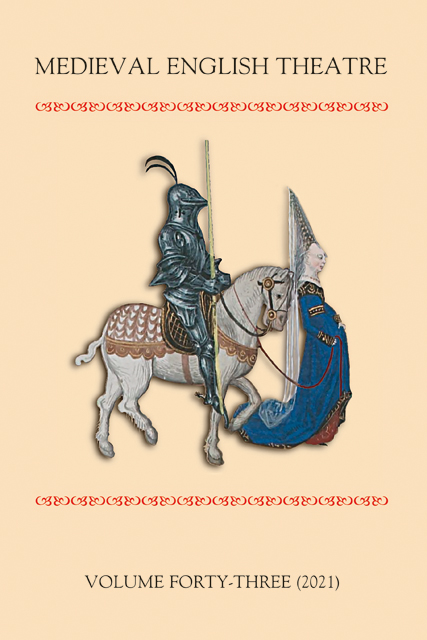Book contents
- Frontmatter
- Contents
- List of Illustrations
- Note on Cover image and Online Links
- List of Common Abbreviations
- Editorial
- The Prince of Peace and the Mummers: Richard II and the Londoners’ Visit of 1376/1377
- Chivalric Entertainment at the Court of Henry IV: The Jousting Letters of 1401
- ‘Maskerye claythis’ for James VI and Anna of Denmark
- Peers and Performers in the Reign of Henry VI
- ‘That Gam Me Thoght Was Good!’: Structuring Games into Medieval English Plays
- Feminism, Theatre, and Historical Fiction: Anna of Cleves in 2021
- Appendix Transcription and Translation of BL MS Cotton Nero D II fols 260v–262r
- Editorial Board
- Submission of Articles
The Prince of Peace and the Mummers: Richard II and the Londoners’ Visit of 1376/1377
Published online by Cambridge University Press: 20 December 2023
- Frontmatter
- Contents
- List of Illustrations
- Note on Cover image and Online Links
- List of Common Abbreviations
- Editorial
- The Prince of Peace and the Mummers: Richard II and the Londoners’ Visit of 1376/1377
- Chivalric Entertainment at the Court of Henry IV: The Jousting Letters of 1401
- ‘Maskerye claythis’ for James VI and Anna of Denmark
- Peers and Performers in the Reign of Henry VI
- ‘That Gam Me Thoght Was Good!’: Structuring Games into Medieval English Plays
- Feminism, Theatre, and Historical Fiction: Anna of Cleves in 2021
- Appendix Transcription and Translation of BL MS Cotton Nero D II fols 260v–262r
- Editorial Board
- Submission of Articles
Summary
This is an expansion of material which Sarah Carpenter and I treated briefly in Masks and Masking. It shows how a folk custom can be adapted, overtly as a mini-drama, and covertly as a means of political negotiation. It also shows how context, expectations, and costume can between them create a message, a message the more powerful because, according to the ‘rules’ of the game, it is delivered in complete silence. Besides this, it raises salutary caveats about our modern expectations: that the ostensible message will be the same as the underlying one.
The story has been told several times by historians of folk custom, of London, and of Richard II. Each group has their agenda and consequently their slant on what they see in it. As far as I know, no-one has attempted to put it in its wider context of the liturgical/festive season and its imaginative baggage, which provided the theme for another major performance piece in the same week, the Chancellor’s speech at the Opening of Parliament – though this also has been treated separately. The sequence and dating of these liturgical feasts and how they provided the setting for both the Parliament and the mumming, is an important part of the following discussion.
This is how it was reported. On the evening of Sunday 1 February 1377, a torch-lit cavalcade passed through the City of London via Cheapside, and crossed the river over London Bridge, making towards Kennington. There were 130 riders, dégisement arrayés (‘dressed in costume’):
Et en le premer comencement chivacherent xlviii come esquiers ount este, deux et deux ensemble, vestuz en cotes et cloches rouge de saye ou de sendelle et lour faces covertes od visers bien et avenablement faitz; et apres ces esquiers veindrent xlviii come chivalers ount este, bien arraiez en mesme la maner; et apres les chivalers vient une excellentment arraye et bien mounte come empereur ust este, et apres luy, par lespace de c pees vient une noblement arraie come une pape; et apres luy viendrent xxiiii come cardinalles / arraiez et apres les cardinalles viendrent viii ou x arraiez ode visers nayrs come deblers nyent amyables, apparauntz come legates …
- Type
- Chapter
- Information
- Medieval English Theatre , pp. 3 - 38Publisher: Boydell & BrewerPrint publication year: 2022



